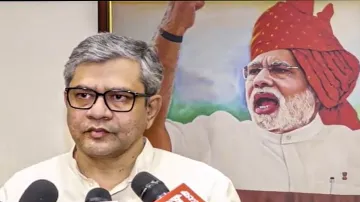The construction work on the Ahmedabad-Mumbai high-speed bullet train project is going under full swing and viaduct pillar work on a 320 km stretch has been completed, Railways Minister Ashwini Vaishnaw said today (August 2).
Besides work on stations and construction of bridges on eight rivers on the 508 km between the two western cities are on advance stage, said Vaishnaw while replying to a supplementary question in the Rajya Sabha.
Though the minister did not replied about any time frame for the project which has already been delayed but said despite disruption during Covid, 320 km has been constructed with a record achievement of time. The bullet train technology is complex and advance and the focus is to adopt it, train our engineers and to create an industrial ecosystem, he said.
This Indian project is discussed globally as the work is going with a fast pace and several innovations have also been done.
"One under-sea tunnel, below 50 meters of the surface in Thane (Maharashtra) has also been started. Moreover work on construction of bridges on eight rivers are also on advance stage," Vaishnaw said.
Replying to a question from BJP's Baburam Nishad, the minister said the Bullet train will have two classes- executive class and normal chair car. Mohammad Nadimul Haq of the TMC wanted to know whether deadline for the project has been extended several times from the initial target of 2022 to 2027.
Though the minister did not mention the delay and said bullet train is a complex technology and several countries have taken over 20 years to complete this project.
"Despite disruption during Covid, 320 km has been constructed in such less time is a record achievement," he said.
Congress member Rajeev Shukla asked why the government is taking undersea route, which takes more construction time and suggested to take a surface route. Vaishnaw said, "There are no impediments in this project. The project is complex and precaution has to be taken at designing stage and after doing that the work is going smoothly."
Sarfaraza Ahmed of the JMM asked whether the government has plans to connect the backwards in East with a similar high speed rail corridor.
The minister said, "The focus is to adopt this complex and advance technology and train our engineers and to create an industrial ecosystem."
Vaishnaw said initially technology for big crane which lifts girders were imported, now it is designed in India. The minister said the countries similar to population like India have adopted the similar strategy to go for elevated railway corridors. In future, the country will have to decide about this, he added.
"Whenever a bullet train projet comes, it connects the economies of four to five cities into one combined economy by reducing the travel time of 100-150 km journey into 15-20 minutes," he said.
"Whether its China, Japan, South Korea, Taiwan, all have done it. This is a very complex technology," he said. The first bullet train projects is coming between Ahmedabad to Mumbai and is coming in collaboration of Japan, which is a pioneer in this technology.
"With the development of the project, the country has assimilation technology in areas such as earthquake-proof Viaduct technology for elevated tracks. Besides, 40 meters full Span Girder, weighing 1,100 tons are placed. Technology for heavy-weight cranes are also being developed in India," he added.
Replying to another question over safety, the minister said now the Indian Railways has done rail renewal of 43,000 km in last 10 years. It is focusing to lay longer rail panels and around 68,000 km has been laid from 2014 to 2024.
ALSO READ: Bullet train project: Bridge over Kolak river completed | Know how much construction work done
ALSO READ: Bullet train project: Construction at Surat train station progresses swiftly, watch new video
Latest India News
